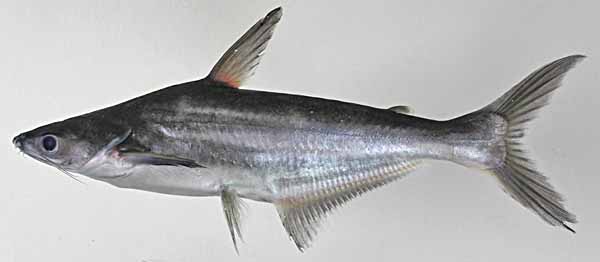Pangasianodon hypophthalmus
(Sauvage, 1878)
|
Familie: Pangasiidae SynonymeHelicophagus hypophthalmus Sauvage, 1878
Pangasius sutchi Fowler, 1937 Lokale Bezeichnung |
 Pangasianodon hypophthalmus (kons. Exemplar MZB 26911) -- (C) Wibowo et al., 2024 in: Acta Ichthyologica et Piscatoria, 54: 95-101. |
Typen
Lectotypus: MNHN A-0745 (dry).
Siehe: Eschmeyer, W.N., Fricke, R. & Van der Laan, R. (eds.) 2024. Catalog of Fishes electronic version
Typusfundort: Laos.
Etymologie
Hypo- (= unten); ophthalmus (= Augen), bezieht sich auf die niedrige Position der Augen am Kopf. (Übersetzt aus: The ETYFish Project)
Verbreitung
Südostasien: Mekong-Becken und Chao Phraya, Thailand; auch in anderen Teilen Asiens, in Kolumbien und in Puerto Rico (USA) in Aquakulturen eingeführt.
IUCN Status

EX Extinct (ausgestorben)
EW Extinct in the Wild (in der Natur ausgestorben)
CR Critically Endangered (vom Aussterben bedroht)EN Endangered (stark gefährdet)
VU Vulnerable (gefährdet)
NT Near Threatened (potenziell gefährdet)
LC Least Concern (nicht gefährdet)
RE Regionally Extinct (regional oder national ausgestorben)DD Data Deficient (ungenügende Datengrundlage)
NE Not Evaluated (nicht beurteilt)
Status: Stand 29.12.2021: NE Not Evaluated (nicht beurteilt)
Gefahren für diese Art: (nicht beurteilt)
Literatur
- Sauvage, H.-E. 1878. Note sur quelques poissons d'espèces nouvelles provenant des eaux douces de l'Indo-Chine. Bulletin de la Société philomathique de Paris, (7th Série) 2: 233-242. Zitatseite [: 235 [3], !!, als Helicophagus hypophthalmus]
- Fowler, H.W. 1937. Zoological results of the third De Schauensee Siamese Expedition. Part VIII,--Fishes obtained in 1936. Proceedings of the Academy of Natural Sciences of Philadelphia, 89: 125-264. Zitatseite [:141, Figs. 27-29, !!, als Pangasius sutchi]
- Ott, G. 1973. Pflege von Pangasius sutchi Fowler (Haiwels). Die Aquarien- und Terrarienzeitschrift (DATZ), 26 (7): 230-232. Zitatseite [:230ff|sw-Foto, (ID?), Aquarienhaltung, als Pangasius sutchi]
- Thiel, A. 1973. Der Siamesische Haiwels, ein nicht ganz einfacher Pflegling. Tatsachen und Informationen aus der Aquaristik (TI), #23 (Sept.): 21. Zitatseite [:21|sw-Foto, Aquarienhaltung, als Pangasius sutchi]
- Harbrecht, R. 1974. Noch einmal Siamesischer "Haiwels" (Pangasius sutchi). Tatsachen und Informationen aus der Aquaristik (TI), #25 (März): 28. Zitatseite [:28|Farbfoto, Aquarienhaltung, als Pangasius sutchi]
- Kottelat, M. 1984. Catalogue des types du Musée d'Historie Naturelle de Neuchâtel. I. Pisces. Bulletin de la Societe Neuchâteloise des Sciences Naturelles, 107: 143-153. Zitatseite [:811, Lectotypus ausgewählt, als Helicophagus hypophthalmus]
- Kahl, B. 1986. Der Haiwels Pangasius sutchi. Aquarien Magazin, 20 (1): 31-33. Zitatseite [:31-33|Farbfoto, Aquarienhaltung, als Pangasius sutchi]
- Riehl, R. & Baensch, H.A. 1990. Aquarien Atlas Band 1. 8. Auflage. Mergus Verlag, Melle. Zitatseite [:509|Farbfoto, (ID?), als Pangasius sutchi]
- Kobayagawa, M. 1991. Faszination Welse. BEDE-Verlag, 160pp. Zitatseite [: 32, Farbfoto, als Pangasius sutchi]
- Roberts, T.R. & Vidthayanon, C. 1991. Systematic revision of the Asian catfish family Pangasiidae, with biological observations and descriptions of three new species. Proceedings of the Academy of Natural Sciences of Philadelphia, 143: 97-143. Zitatseite [:121, als Pangasius hypophthalmus; Pangasius sutchi als Synonym]
- van den Nieuwenhuizen, A. 1995. Bung Borapet. Die Aquarien- und Terrarienzeitschrift (DATZ), 48 (11): 734-738. Zitatseite [:734*|?Farbfoto, als Pangasius sutchi]
- Rainboth, W.J. 1996. FAO species identification field guide for fishery purposes. Fishes of the Cambodian Mekong. Rome, FAO. 1-265, Pls. I-XXVII. Zitatseite [:153, als Pangasianodon hypophthalmus]
- Yuniar, A.T., Rückert, S. & Walter, T. 2005. Ikan patin - Haiwelszucht in Indonesien. Die Aquarien- und Terrarienzeitschrift (DATZ), 58 (2): 70-72. Zitatseite [:70-72|Farbfoto, Vorkommen, Fortpflanzung ]
- Pokieser, H. 2006. Der Riese vom Mekong. Aquaristik Fachmagazin, #188, 38 (2): 56-59. Zitatseite [:57*|Farbfoto ]
- So, N., Maes, G.E. & Volckaert, F.A.M. 2006. High genetic diversity in cryptic populations of the migratory sutchi catfish Pangasianodon hypophthalmus in the Mekong River. Heredity, 96: 166-174. Zitatseite [:166ff|Genetik ]
- So, N., Van Houdt, J.K. & Volckaert, F.A. 2006. Genetic diversity and population history of the migratory catfishes Pangasianodon hypophthalmus and Pangasius bocourti in the Cambodian Mekong River. Fisheries Science, 72: 469–476. (doi) Zitatseite
- Haslawati, B., Amatul-Samahah, M.A., Rizman-Idid, M. & Muniandy, S. 2023. DNA Barcoding and Phylogenetics Relationship of Pangasiid Catfishes in Peninsular Malaysia Revealed the Impacts of Aquaculture on the Native Species Conservation. Hydrobiology, 2 (2): 431-445. (doi) Zitatseite
- Wibowo, K., Muslim, M., Afrisal, M., Priyadi, A., Kusumah, R.V. & Lukman, L. 2024. First records of two siluriform fishes: Bagrichthys micranodus (Actinopterygii: Siluriformes: Bagridae) and Pangasianodon hypophthalmus (Pangasiidae) from Sumatra, Indonesia. Acta Ichthyologica et Piscatoria, 54: 95-101. (doi) Zitatseite [:97, Figs 1B & C, Farbfoto, Beschreibung, Verbreitung: Cala-See, Musi Banyuasin, Süd-Sumatra]